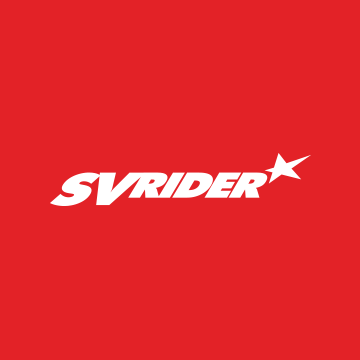After reading the thread called called "New sprockets", I feel this subject is worth its own thread. I've read everything I could find on the subject of sprocket changes on this and other Strom sites, and still feel the subject hasn't been clearly and completely addressed. Usually it's a "Whole new bike!" or "Love it!" kind of thing that doesn't get detailed enough. Not enough for me, anyway. Some may feel that I'm scourging an expired equine, but if I thought so I wouldn't be outgassing in this fashion. With that said:
I don't know why this bike comes from the factory with a 17-tooth front sprocket and a 41-tooth rear sprocket. Who can fathom the inscrutable minds of Japanese motorcycle manufacturers? To cite one example, why did they wait nearly 20 years to fix the irksome deficiencies of the KLR650? Ever heard of the doohickey? Yes, that's Kawasaki, but the phenomenon of Asian bike builders not quickly addressing issues that are often bad enough to spawn healthy and long-lived aftermarket industries is legendary.
To be fair, the sprocket ratio of the DL1000 may have something to do with emissions and dynamometer tests. Who knows.
Back to the DL1000: If you tour, and especially if you head off the asphalt or concrete onto steep, bumpy, or rutted roads--or all of those--the problem with the stock 17/41 sprocket setup becomes quickly evident. If you have a heavy load on the bike, it's even more evident, and more irritating.
First gear for the DL1000, regardless of the sprocket setup, is generally too low for "cruising" on any rough road. The bike's throttle response is too violent, and easing up on the throttle once you have reached a speed of only a few miles per hour causes the bike to jerk -- especially unnerving if you're riding standing up, as it suddenly pitches you forward. For bad roads or slow cruising, you must be in second gear. And that's the problem in the stock 17/41 sprocket setup. It's too "tall" -- geared too high -- for this purpose. At speeds of 15-25 MPH, the comfort range for tooling along comfortably on a lumpy or rutted dirt/gravel road, the engine revs are too low. And if you get into any sort of trouble, like suddenly having to climb a steep section or go over a short ledge, you don't have the torque available. You find yourself increasing the revs and slipping the clutch constantly. It works but it's tiresome.
At the other end of the spectrum, with the stock 17/41 setup, it is universally agreed that overdrive (6th gear) is fairly useless on the DL1000 unless you're going to continually and greatly exceed the common 70-75 MPH interstate speed. If you have a heavy or bulky load, or are heading into the wind, the uselessness of this gear is doubly underscored. In sum, to use OD on the Vee you have to keep the speed and revs up far higher than the usual prevailing traffic, and if you need an even moderately rapid increase in speed, you're going to be downshifting.
I tried the stock 17/41 for a couple of months after buying the bike. Even with nothing loaded on the bike, that sprocket setup was not suited to bad-road riding. Then I went to 17/43 for a few months. While this was a noticeable improvement for low-speed cruising on any type of road, overdrive was still pretty useless.
I finally bought a 16-tooth SunStar. Wrenched it on. Rode the bike.
Now that's what I'm talkin' about. That's the thing about which I speak. That's the subject upon which I'm holding forth. The bike is happy -- snappier, better RPM range for each gear, perfect for low-speed bumping along rutted roads, absolutely no problem starting out with a heavy load, even on a steep incline. And best of all, sixth gear is now usable. Higher revs and more torque available at normal interstate speeds. Less downshifting, if any at all, when passing trucks or doing any other maneuvering. Perfect.
By the way, I'm sure 16/44 would be fine. And 17/45 is also close to the 16/43 ratio. The big advantage of 16/43 is that you don't have to buy a new chain. Total cost for this absolutely great modification is about $60. You won't spend better money on the DL1000.
As for gas mileage, who cares? I just want the bike to perform, and if I spend another $50-$100 a year in gas to get this performance (which may not even be the case, by the way) then I figure that's an astounding bargain.
I don't know why this bike comes from the factory with a 17-tooth front sprocket and a 41-tooth rear sprocket. Who can fathom the inscrutable minds of Japanese motorcycle manufacturers? To cite one example, why did they wait nearly 20 years to fix the irksome deficiencies of the KLR650? Ever heard of the doohickey? Yes, that's Kawasaki, but the phenomenon of Asian bike builders not quickly addressing issues that are often bad enough to spawn healthy and long-lived aftermarket industries is legendary.
To be fair, the sprocket ratio of the DL1000 may have something to do with emissions and dynamometer tests. Who knows.
Back to the DL1000: If you tour, and especially if you head off the asphalt or concrete onto steep, bumpy, or rutted roads--or all of those--the problem with the stock 17/41 sprocket setup becomes quickly evident. If you have a heavy load on the bike, it's even more evident, and more irritating.
First gear for the DL1000, regardless of the sprocket setup, is generally too low for "cruising" on any rough road. The bike's throttle response is too violent, and easing up on the throttle once you have reached a speed of only a few miles per hour causes the bike to jerk -- especially unnerving if you're riding standing up, as it suddenly pitches you forward. For bad roads or slow cruising, you must be in second gear. And that's the problem in the stock 17/41 sprocket setup. It's too "tall" -- geared too high -- for this purpose. At speeds of 15-25 MPH, the comfort range for tooling along comfortably on a lumpy or rutted dirt/gravel road, the engine revs are too low. And if you get into any sort of trouble, like suddenly having to climb a steep section or go over a short ledge, you don't have the torque available. You find yourself increasing the revs and slipping the clutch constantly. It works but it's tiresome.
At the other end of the spectrum, with the stock 17/41 setup, it is universally agreed that overdrive (6th gear) is fairly useless on the DL1000 unless you're going to continually and greatly exceed the common 70-75 MPH interstate speed. If you have a heavy or bulky load, or are heading into the wind, the uselessness of this gear is doubly underscored. In sum, to use OD on the Vee you have to keep the speed and revs up far higher than the usual prevailing traffic, and if you need an even moderately rapid increase in speed, you're going to be downshifting.
I tried the stock 17/41 for a couple of months after buying the bike. Even with nothing loaded on the bike, that sprocket setup was not suited to bad-road riding. Then I went to 17/43 for a few months. While this was a noticeable improvement for low-speed cruising on any type of road, overdrive was still pretty useless.
I finally bought a 16-tooth SunStar. Wrenched it on. Rode the bike.
Now that's what I'm talkin' about. That's the thing about which I speak. That's the subject upon which I'm holding forth. The bike is happy -- snappier, better RPM range for each gear, perfect for low-speed bumping along rutted roads, absolutely no problem starting out with a heavy load, even on a steep incline. And best of all, sixth gear is now usable. Higher revs and more torque available at normal interstate speeds. Less downshifting, if any at all, when passing trucks or doing any other maneuvering. Perfect.
By the way, I'm sure 16/44 would be fine. And 17/45 is also close to the 16/43 ratio. The big advantage of 16/43 is that you don't have to buy a new chain. Total cost for this absolutely great modification is about $60. You won't spend better money on the DL1000.
As for gas mileage, who cares? I just want the bike to perform, and if I spend another $50-$100 a year in gas to get this performance (which may not even be the case, by the way) then I figure that's an astounding bargain.





